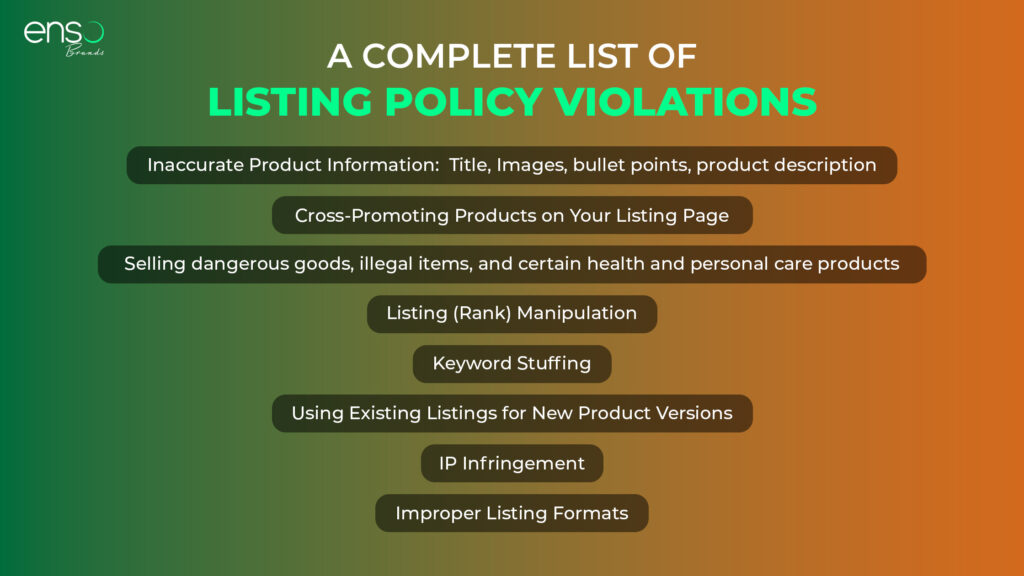Amazon Seller Policy Violation: How to Ensure Compliance With Listing Policies
Amazon gives sellers plenty of freedom when it comes to selling products on their platform. However, every seller is required to follow a set of rules and regulations. While this might seem a bit overwhelming, the list is actually quite manageable. If you fail to follow these rules, it can lead to consequences such as deactivation of your account, suspension until issues are resolved, or even fines.
In this blog, we’ll dive into Amazon’s listing policies, explain what happens if you break them, and help you stay on the right track.
Select the plan that best suits your needs and begin your journey today.
Listing Policy Violations Every Amazon Seller Needs to Know About
When you start selling on Amazon, it’s important to understand the platform’s listing policies. These rules are designed to make shopping easy for customers and maintain a fair environment for sellers.
Here are some key policies every seller needs to know about:

1) Inaccurate Product Information
Amazon stresses again and again that one of its most important listing policies is to provide accurate and truthful product information. This includes the title, images, bullet points, product description, and any other details about the item you are selling.
A customer is going to make a purchase decision based on what they read and see in your listing. Misleading information or exaggerating product features can lead to them being dissatisfied, which is the last thing Amazon wants. In fact, if the e-commerce giant catches you doing this, it could lead to an immediate deactivation of your account.
2) Cross-Promoting Products on Your Listing Page
Your Amazon product detail page is meant to be solely dedicated to the product you’re selling. Amazon strongly discourages using any part of your listing – including images, descriptions, or other related information – to advertise other products you sell. This policy is designed to make sure customers aren’t confused or misled when they’re viewing your product.
If you want to promote your other products without violating Amazon’s rules, you can use A+ Content or virtual bundles. With certain A+ modules, you can discuss your brand as a whole and even link to other products of yours. With virtual bundles, you can use prime real estate on your listing to bundle items together.
3) Selling Prohibited Items
Amazon has a list of restricted and prohibited items that cannot be listed for sale. These include dangerous goods, illegal items, and certain health and personal care products. Before you list anything for sale, make sure to check these lists and abide by them. Attempting to sell or list restricted products can cause serious legal implications, affect your product rankings, and even lead to your account being suspended or deactivated.
4) Listing (Rank) Manipulation
Attempting to alter product rankings, reviews, or ratings on Amazon is strictly forbidden and taken very seriously by the platform. This includes offering incentives for positive reviews, posting fake reviews, or artificially boosting sales through unethical means. Gone are the days of deep discounts and brand rebates. These practices not only go against Amazon’s rules but also impacts trust with customers.
5) Keyword Stuffing
Amazon discourages keyword stuffing, which is the practice of excessively using keywords to manipulate rankings. While including relevant keywords that accurately describe your product is important for improving your product’s visibility, using too many irrelevant keywords can lead to listing suspensions. Also, keep in mind that listing policy violations can also arise from using keywords that are restricted by Amazon.
To find relevant keywords, you can always use tools like Amazon’s Keyword Tool, analyze competitor listings, or use third-party keyword research tools like Helium10.
6) Using Existing Listings for New Product Versions
When you’re selling a new version of the same product on Amazon, it’s important to understand what qualifies as a “new version.” Any changes to the product’s name, color, size, material, or features make it different enough to require its own separate listing. Trying to add a new version as a variation isn’t allowed and can lead to your listing being suppressed.
Unfortunately, new sellers might involuntarily make this mistake without realizing Amazon’s rules. However, some sellers might try to do this on purpose, hoping to benefit from the reviews and ratings of an existing product. However, it’s important to note that Amazon uses rigorous monitoring procedures to identify such instances. Penalties for violating this policy can be severe, and Amazon will not hesitate to enforce them.
7) Intellectual Property (IP) Infringement
Amazon takes intellectual property rights seriously and expects its sellers to do the same. Selling counterfeit or unauthorized copies violates these rights and can lead to severe consequences, including account suspension.
To avoid this, it’s important to make sure your products are genuine and that you have obtained proper seller agreement permissions from brand owners to sell them. If you own a brand and want to protect it from third-party sellers, consider enrolling in the Amazon Brand Registry program.
8) Improper Listing Formats
Amazon has specific guidelines for how listings must be formatted. This includes specific rules about the image sizes, bullet points, and other formatting details. Using improper listing formats not only impact the user experience but also violates Amazon’s listing policies.
Here are some key points to keep in mind regarding listing formats:
Product Title: Your title should be 150 to 200 characters long and include details such as the brand name, product type, material, size, quantity, and color.
Product Images: Amazon allows sellers to include a maximum of 9 images. The main image must feature a pure white background, and the product should fill at least 80% of the image space.
Product Features (Bullet Points): For the bullet points, highlight the product’s key features using up to five points (500 characters each). Make sure not to include any icons or emojis.
Product Description: For the product description, include additional details about the product, using up to 2,000 characters. You can use HTML tags to make it easier to read.

How Do You Know If You’ve Violated Amazon’s Listing Policies?
Amazon does a good job of monitoring its marketplace, and if you’ve violated a rule, they will likely inform you. Here’s how to tell if you’ve breached Amazon’s policies:
Amazon Notifications: Amazon will send you a notification if they believe you’ve violated one of their policies. This usually comes via email or your Seller Central account. They will specify what the violation is and which listing it pertains to. Always keep an eye on your notifications, and don’t ignore any messages from Amazon.
Account Health Dashboard: Use the Account Health Dashboard in your Amazon Seller account to regularly review your seller performance metrics. It’ll tell you if there are any policy warnings or violations so that you can resolve the issue before it escalates.
What Should You Do If You Violate Amazon’s Listing Policies?
If you break Amazon’s strict listing policies, it can be stressful. But don’t panic! Amazon gives you clear steps to fix the problem.
Here’s what to do:
Step 1: Identify the Violation
First, figure out what policy you violated. Check the warning or notification you received from Amazon. It should detail the policy violation and the specific listing it pertains to. Next, research the policy, and read about it on Amazon’s guidelines to understand why your listing violated it.
Step 2: Take Corrective Action
Once you’ve identified the violation, take swift action to correct it. If the violation pertains to a specific product, you might need to remove the product from your listings immediately. If there is an issue with the listing information, update it as soon as you can to align with Amazon’s guidelines.
Step 3: Reach Out to Amazon Support
Once you’ve fixed the issue, reach out to Amazon’s seller support. Inform them about the violation and explain in detail what you did to fix it. Being upfront and open with Amazon shows you’re serious about following the policies.
Step 4: Regularly Monitor and Audit Your Listings
After resolving a specific violation, make sure to keep an eye out to avoid more in the future. Regularly review and audit your listings to make sure they comply with Amazon’s policies. And remember, Amazon’s guidelines might change, so stay updated.
Can You Report Amazon Listings?
Of course, you can. In fact the platform encourages Amazon sellers to report listings if they find that another seller has violated their intellectual property rights or when dealing with an unauthorized seller who has hijacked their listing.
Here’s how to report a listing:
Step 1: Collect Evidence
The first thing you need to do is collect evidence of the fraudulent activity. Make sure you have:
– The name of the store or business you’re reporting.
– The ASIN, title, and URL of the listing.
– A clear explanation of what policy the seller violated.
– Any supporting documents like IDs, receipts, or messages related to the issue.
Step 2: Report the Issue
After identifying the Amazon listing violation and gathering evidence, it’s time to report it via Report Abuse on Seller Central. Fill out the form with all the necessary details, including the type of violation and the marketplace where it happened. Make sure to provide complete information. Once you submit the form, Amazon will send a confirmation email.
Step 3: Check for Updates
After filing the complaint, Amazon may take a few days to respond. If you don’t receive a follow-up email or hear from them, reach out to Amazon’s Seller Support.
FAQ Section
Q: How can I improve my product’s visibility on Amazon?
First, make sure that your product titles, bullet points, and descriptions are optimized with relevant keywords. You can also try using sponsored ads and Amazon’s A+ Content feature to boost visibility.
Q: What should I do if my Amazon seller account gets suspended?
If your Amazon seller account gets suspended, the first step is to carefully review the notification from Amazon outlining the reason for the suspension. Once you know why, formulate a plan of action to fix it and send an appeal through your Seller Account. Amazon will review your appeal and decide whether to reinstate your account. If your claim gets rejected, reach out to Seller Support.
Q: Can I sell internationally on Amazon?
Yes, Amazon allows sellers to sell their products internationally through various marketplaces such as Amazon Europe, Amazon Japan, and others. However, this requires careful consideration of shipping logistics, language barriers, and local regulations.
To sell internationally, consider enrolling in Amazon’s Global Selling program and using tools like Amazon’s currency converter and translation service.
Q: How does Amazon handle counterfeit products?
Amazon has a zero-tolerance policy towards counterfeit products. Sellers found to be listing counterfeit items can face severe penalties, including legal action and permanent account suspension.
Q: What should I do if my product is mistakenly identified as a prohibited item?
If your product has been mistakenly flagged as prohibited, you should contact Amazon Seller Support immediately. Provide detailed information and evidence to support your claim that your product complies with Amazon’s policies. This may include certifications, product details, and other relevant documents.
Q: How often should I review Amazon’s policy updates?
Amazon’s policies can change, so it’s important to review them regularly. We recommend checking for updates at least once a month or signing up for Amazon’s seller notifications to receive updates directly.
Summary
Understanding and following the Amazon sales process, but it’s doable with the right approach. Stick to the rules, and you can build a successful Amazon business. Remember, rules can vary depending on what you’re selling, so make sure you know the ones for your product category to stay out of trouble.
Looking for expert assistance in managing your Amazon seller accounts? Enso Brands offers a comprehensive range of one-stop Amazon services tailored to optimize your performance and maximize your potential on the platform. Contact us today and discover how we can help your business thrive on Amazon!
Transform Your Amazon Presence: Unlock Sales and Dominate with Our Ultimate Listing and Design Templates!
-
Expert advice and insider tips on creating a perfect Amazon listing
-
Product Insert Template
-
Product Packaging Template
-
Amazon Posts Template
Ready to elevate your Amazon business? Our expert team at Enso Brands is here to provide tailored solutions that drive results.







